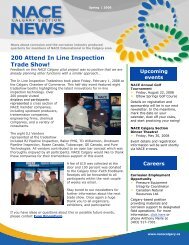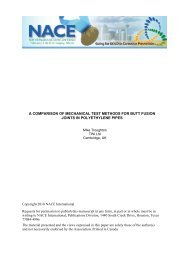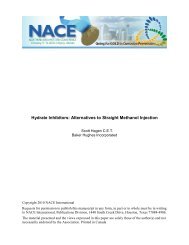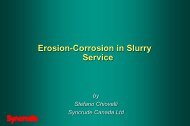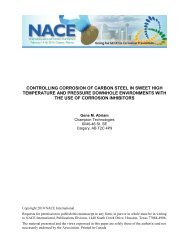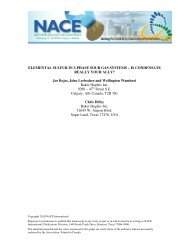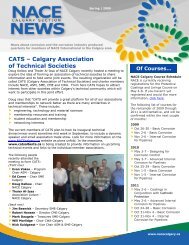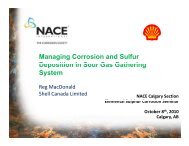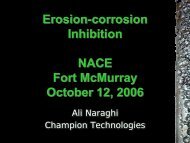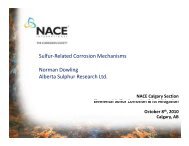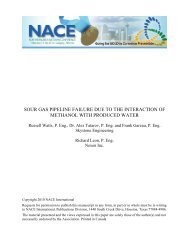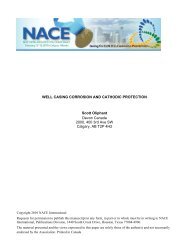Boiler Tube Failure, Prevention and Control - NACE Calgary
Boiler Tube Failure, Prevention and Control - NACE Calgary
Boiler Tube Failure, Prevention and Control - NACE Calgary
You also want an ePaper? Increase the reach of your titles
YUMPU automatically turns print PDFs into web optimized ePapers that Google loves.
<strong>Boiler</strong> <strong>Tube</strong> <strong>Failure</strong>,<br />
<strong>Prevention</strong> <strong>and</strong> <strong>Control</strong><br />
Mike Rogers<br />
Alberta Technology & Science Inc<br />
October 12, 2006
Introduction<br />
• The content of this short presentation is<br />
expected to give you the ability to:<br />
– Explain four reasons why large number of repeat<br />
boiler tube failures. i.e. same failure mechanism,<br />
same root-cause, same tube, etc., occur in fossil-fired<br />
boilers<br />
– Describe the six requirements for a formalized boiler<br />
tube failure prevention program<br />
– Discuss twenty-two common tube failure mechanisms<br />
in terms of typical locations, appearances, rootcauses,<br />
corrective action, etc<br />
2
Definitions<br />
• A boiler tube is considered to have a<br />
failure when<br />
– Its pressure boundary is broken by a leak or<br />
rupture, or prone to be broken due to wall<br />
thinning before the next scheduled boiler<br />
inspection<br />
3
Repeat failures are defined as multiple failures<br />
in a single boiler having the same failure<br />
mechanism <strong>and</strong> root-cause<br />
• Repeat boiler tube failures occur for the<br />
following reasons:<br />
– Not following state-of-the-art practices<br />
– Lack of proper tube failure analysis<br />
– Wrong choice of corrective/preventive action<br />
– Lack of tube failure reporting <strong>and</strong> monitoring<br />
4
Not following state-of-the-art<br />
practices<br />
• State-of-the-art practices are defined as<br />
operation, maintenance <strong>and</strong> engineering<br />
practices demonstrated by experience to<br />
be necessary in the prevention of repeat<br />
boiler tube failures <strong>and</strong> fall into the<br />
following categories:<br />
– Operating practices<br />
– Maintenance practices<br />
– Engineering practices<br />
5
State-of-the-Art Operating<br />
Practice<br />
• Major operating practices influencing<br />
boiler tube failure are:<br />
– Cycle water chemistry<br />
– <strong>Boiler</strong>, superheater <strong>and</strong> reheater temperature<br />
control<br />
– Combustion control<br />
– Waterside <strong>and</strong> fireside layup<br />
6
EXAMPLE (operating)<br />
• These costly repeat failure problems can<br />
be eliminated by the establishment <strong>and</strong><br />
use of plant action-oriented operating<br />
procedures; where these procedures<br />
define not only normal limits for boiler<br />
water chemical parameters, but also<br />
proper corrective action to be taken when<br />
parameter limits are exceeded<br />
7
EXAMPLE (Maintenance)<br />
• Establish <strong>and</strong> use of plant repair<br />
procedure; where these procedures clearly<br />
define not only the repair method <strong>and</strong><br />
materials to be used, but also proper<br />
quality-control action to be taken to ensure<br />
against boiler tube-repair repeat failures<br />
8
EXAMPLE (Engineering)<br />
• Establish <strong>and</strong> use of plant boiler tube<br />
inspection procedures; where the<br />
procedures clearly define not only the<br />
method for verifying the integrity of the<br />
tube repair, such as radiography <strong>and</strong>/or<br />
hydrostatic test, but also proper residual<br />
life preventive action to be taken to ensure<br />
against loss-of-life-damage repeat tube<br />
failures<br />
9
Lack of proper failure analysis<br />
• Analysis of a tube failure incident should<br />
include:<br />
– Inspections to determine the extent of primary<br />
<strong>and</strong> secondary tube damage<br />
– Identification of the failure mechanism<br />
– Determination of the root-cause<br />
– Determination of residual life/predictive<br />
maintenance<br />
10
Formalized <strong>Boiler</strong> <strong>Tube</strong> <strong>Failure</strong><br />
<strong>Prevention</strong> Program<br />
• Every boiler tube failure will be reported <strong>and</strong><br />
documented by responsible personnel in a<br />
comprehensive format describing:<br />
– Specific boiler <strong>and</strong> tube locations<br />
– <strong>Failure</strong> mechanism<br />
– Root-cause <strong>and</strong> verification basis<br />
– Type of repair <strong>and</strong> name of repairee<br />
– Type <strong>and</strong> extent of prerepair-inspection <strong>and</strong> name of<br />
inspector<br />
– Future preventive <strong>and</strong> control action taken or<br />
recommended<br />
11
<strong>Failure</strong> mechanisms<br />
• Primary <strong>Failure</strong> Mechanisms<br />
– A mechanism is defined as the process by<br />
which something comes into being. There are<br />
six broad classifications<br />
• Stress rupture<br />
• Water-side corrosion<br />
• Fire-side corrosion<br />
• Erosion<br />
• Fatigue<br />
• Lack of quality control<br />
12
Stress Rupture<br />
• Short-Term Overheating<br />
• High Temperature Creep<br />
• Dissimilar Metal Welds<br />
13
Water-Side Corrosion<br />
• Caustic Corrosion<br />
• Hydrogen Damage<br />
• Pitting (Localized Corrosion)<br />
• Stress Corrosion Cracking<br />
14
Fire-Side Corrosion<br />
• Low temperature<br />
• Waterwall<br />
• Coal Ash<br />
15
Erosion<br />
• Fly Ash<br />
• Falling Slag<br />
• Soot blower<br />
• Coal Particle<br />
16
Fatigue<br />
• Vibration<br />
• Thermal<br />
• Corrosion<br />
17
Lack of Quality <strong>Control</strong><br />
• Maintenance Cleaning Damage<br />
• Chemical Execution Damage<br />
• Material Defects<br />
• Welding Defects<br />
18
Root-Cause Analysis an<br />
Verification Methods<br />
• <strong>Tube</strong> metal temperature<br />
• <strong>Tube</strong> metal stress<br />
• <strong>Tube</strong> metal thickness<br />
• <strong>Tube</strong> metal microstructure<br />
• <strong>Tube</strong> metal material properties<br />
• <strong>Boiler</strong> water <strong>and</strong> feedwater chemistry<br />
• <strong>Boiler</strong> water flow<br />
• Fuel constituents<br />
• Fuel fouling <strong>and</strong> slagging characteristics<br />
• Flue gas flow pattern <strong>and</strong> velocity<br />
• Flue gas temperature<br />
• <strong>Tube</strong> deposit constituents <strong>and</strong> thickness<br />
19
Six steps in boiler tube failure<br />
investigation<br />
• Isolate the probable failure mechanism by the<br />
tube failure location <strong>and</strong> position<br />
• Select the actual failure mechanism by<br />
assessing other relevant failure characteristics<br />
• Select the probable root-cause of the failure<br />
• Verify the most probable root-cause of failure<br />
• Assess the need for, <strong>and</strong> selection of the<br />
residual life methodology<br />
• Select corrective/preventive actions directed<br />
towards permanent solutions<br />
20
Short-Term Overheating<br />
• Blockage of tube internally<br />
• Loss of boiler coolant circulation or low<br />
water level<br />
• Loss of coolant due to an upstream tube<br />
failure<br />
• Overfiring or uneven firing of boiler fuel<br />
burners<br />
21
High Temperature Creep<br />
• Partial blockage by debris, scale, or deposits<br />
• Exposure to radiant heat<br />
• Before the change to a higher grade material<br />
• Just above the final outlet header<br />
• Exposure to high gas temperature due to<br />
blockage of gas passages or laning<br />
• Have incorrect grade of steel material<br />
• Have higher stresses due to welded attachments<br />
22
Causes of high temperature<br />
creep<br />
• Restriction of the tube’s coolant flow internally by<br />
scale, debris, or condensate<br />
• Reduction of heat transfer capability due to<br />
internal (steam-side) surface oxide scales or<br />
chemical deposits<br />
• Periodic Overfiring or uneven firing of fuel<br />
burners<br />
• Blockage or laning of boiler gas passages<br />
• Operation of a tube material at temperatures<br />
higher than allowable<br />
• Increases in stress due to wall thinning<br />
23
Causes of dissimilar metal weld<br />
cracking<br />
• Application of high temperatures <strong>and</strong><br />
stresses that exceed the expected design<br />
values<br />
24
Causes of caustic corrosion<br />
• Selective deposition of feedwater system<br />
or preboiler corrosion products at locations<br />
of high heat flux<br />
• Concentration of sodium hydroxide from<br />
boiler water chemicals or from upsets in<br />
the water chemistry<br />
25
Pitting (Localized corrosion)<br />
• Exposure of the tube to water with high<br />
acidic or oxygen concentrations<br />
• Existence of close-fitting surfaces <strong>and</strong><br />
deposits where differences in oxygen<br />
concentration can be produced<br />
26



